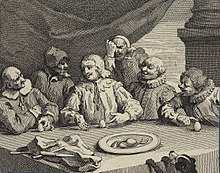
An egg of Columbus or Columbus's egg (Italian: uovo di Colombo [ˈwɔːvo di koˈlombo]) refers to a seemingly impossible task that becomes easy once understood. The expression refers to an apocryphal story, dating from at least the 16th century, in which it is said that Christopher Columbus, having been told that finding a new trade route was inevitable and no great accomplishment, challenges his critics to make an egg stand on its tip. After his challengers give up, Columbus does it himself by tapping the egg on the table to flatten its tip.
The story is often alluded to when discussing creativity.[1] The term has also been used as the trade name of a tangram puzzle and several mechanical puzzles.
- ^ Kant, Immanuel (2013[1790]), Critique of Judgement, Book II, "Analytic of the Sublime", Simon and Schuster: "In my part of the country, if you set a common man a problem like that of Columbus and his egg, he says, 'There is no art in that, it is only science': i.e. you can do it if you know how; and he says just the same of all the would-be arts of jugglers."